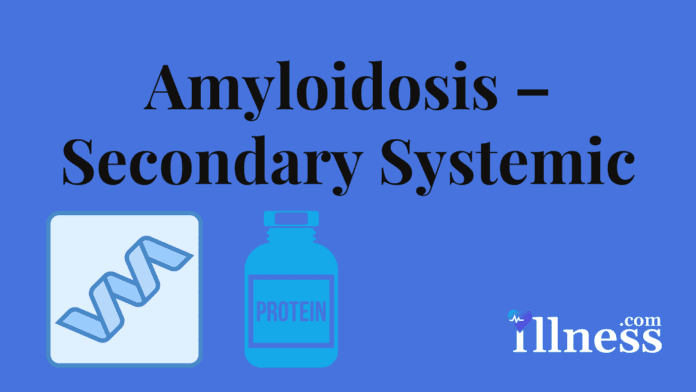Overview Of Amyloidosis – Secondary Systemic
Secondary systemic amyloidosis is a condition in which abnormal protein deposits, called amyloid deposits, build up in organs and tissues throughout the body. “Secondary” means that this condition results from another medical problem or disease.
For example, long-term/chronic inflammation or infection often causes secondary systemic amyloidosis. In contrast to this, primary amyloidosis occurs whenever no other disease exists in the body to cause it – it happens on its own.
Commonly Associated With
Ohio Type Amyloidosis (Type VII), AA amyloidosis, and Idiopathic Amyloidosis
Causes Of Amyloidosis – Secondary Systemic
What exactly causes this condition is currently unknown. But, secondary systemic amyloidosis is more likely to develop if the person has a chronic infection or problems with inflammation. Due to this, a lot of inflammatory conditions, and conditions that cause repeated infections, are associated with the condition.
This condition can occur alongside:
- Tuberculosis
- Familial Mediterranean fever — an inherited disorder that causes repeated fevers and inflammation. This inflammation then typically affects the person’s chest area, lining of the abdomen, or joints
- Rheumatoid arthritis
- Bronchiectasis — a disease in which the large airways in the lungs are damaged due to chronic infections
- Multiple myeloma — a variety of blood cancer
- Hodgkin’s disease — a lymph tissue cancer
- Reiter syndrome — a group of related conditions that cause inflammation and swelling of the eyes, joints, and urinary/genital systems
- Chronic osteomyelitis — a bone infection
- Cystic fibrosis — a disease that causes sticky and thick mucus material to build up in the lungs, digestive tract, and other body areas. This then leads to chronic lung infections. As a result of this condition, respiratory failure can occur
- Ankylosing spondylitis — a form of arthritis that usually affects the joints and bones of the spine
- Hairy cell leukemia — a specific type of blood cancer
- Juvenile idiopathic arthritis — arthritis in children
- Systemic lupus erythematosus — an autoimmune disorder
Symptoms Of Amyloidosis – Secondary Systemic
What symptoms a person will experience from secondary systemic amyloidosis depends on what body tissue or organ is being invaded by protein deposits. In other words, these deposits will damage the tissues they invade, and what symptoms result from that depend on where it happens.
Common symptoms due to these deposits include:
- Numbness of feet or hands
- Fatigue
- Unintentional weight loss
- Shortness of breath
- Bleeding underneath the skin
- A swollen tongue
- Swollen legs or arms
- A weakened hand grip
- A rash
- An irregular heartbeat
- Swallowing difficulties
Exams & Tests
A health care provider will ask the person about their symptoms, and will then perform a physical exam. After the physical exam, if they are still unsure of the diagnosis or wish to confirm it, they may order additional tests.
Possible diagnostic tests can include:
- A skin biopsy
- An electrocardiogram (ECG)
- An abdominal ultrasound (which then may reveal a swollen spleen or liver)
- A rectal biopsy
- A nerve conduction velocity test
- A urinalysis
- A biopsy or aspiration of subcutaneous fat (just under the skin)
- A bone marrow biopsy
- Blood tests, such as a BUN and creatinine exam
- An echocardiogram
Treatment Of Amyloidosis – Secondary Systemic
Treating whatever primary condition is causing the secondary systemic amyloidosis is always a good idea. That is to say, if that condition is curable, the amyloidosis should be as well. After that cure, the amyloidosis should clear up.
In some cases where the primary cause is more difficult to treat, the medication colchicine could be prescribed, as well as another type of medication that treats the immune system. In conclusion, whether or not the condition is treatable depends very heavily on the primary medical problem causing it.



